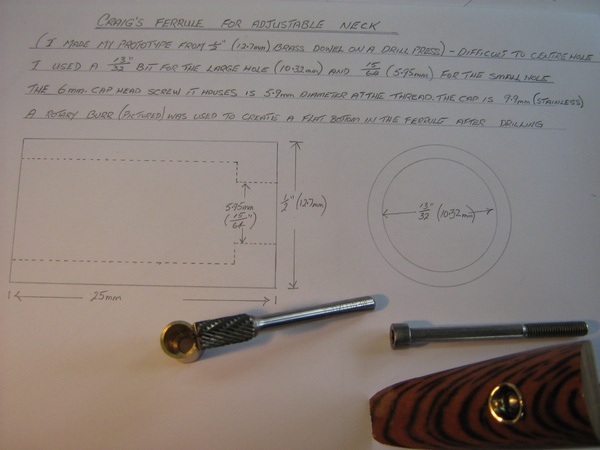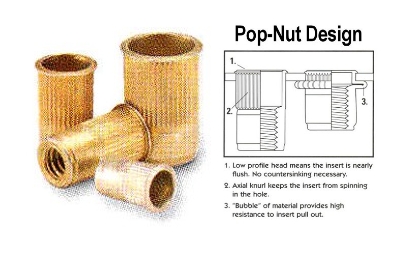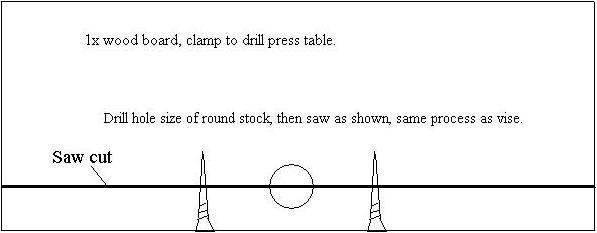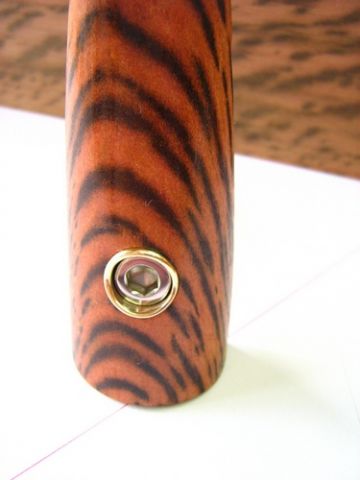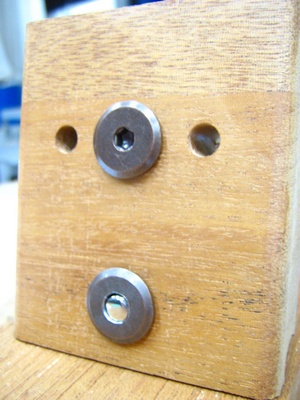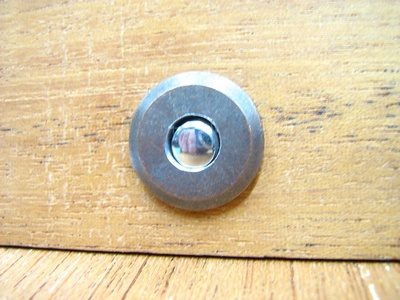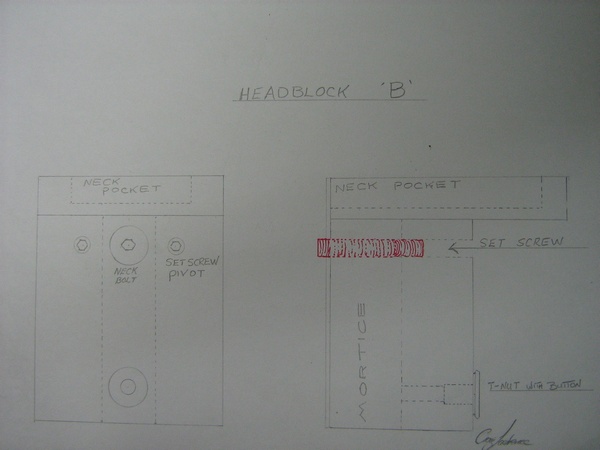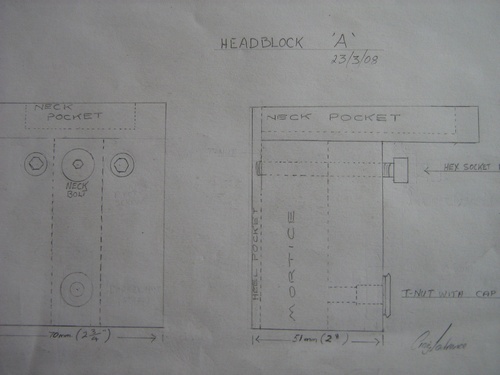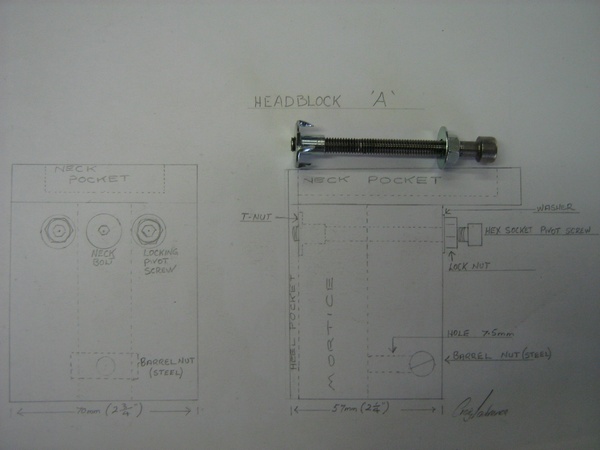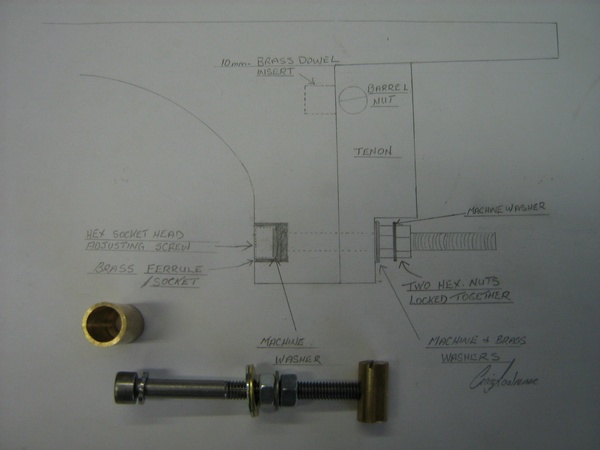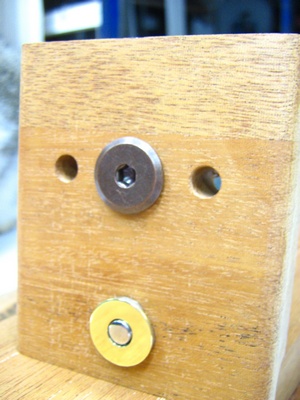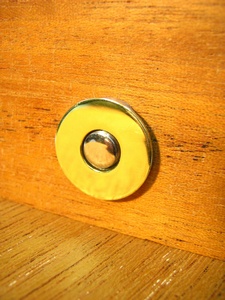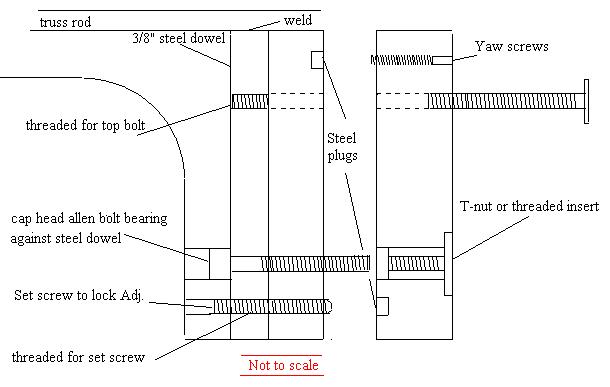Craig L wrote:... I also gave the set screw into wood ( creating their own thread ) , thing a good go. ... I must say that I'm fairly impressed with their performance.
...
Dennis , we are trying for an external adjusting system, that is ,if we can design one that will work reliably. It would be a whole lot easier to deal with an internal adjustment with a locking screw . That's been handled by people like Dave without problems ,as far as I know. To be able to adjust the string action , without having to loosen the strings and dive into the soundhole would be a great advantage . This is what we are striving for, and hopefully achieve.
You mention the intonation thing again . We have covered that in a fair amount of detail , and discovered that this isn't an issue at all. This was confirmed by Dave who is experienced with his adjustable system , and also with my calculations showing that with a pivot point of 30 mm. from the fretboard , the string length only increases it's length by .093 mm. ( around 3 1/2 thou ) , when lowering the string action .5 mm above the twelfth fret. Intonation is of no concern.
Whatdoyareckon ?
Cheers Craig
I modeled what I was going to do in CAD, and saw about 4 thousandths (inches) difference in string length from the highest to the lowest reasonable adjustment. I believed I would not be able to detect a change in intonation when I changed the neck pitch, but it was easily heard. Maybe I was physically off further that the theoretical 4 thousandths. I have no argument with Dave's ears, but my physical guitar did have an intonation change with an action change. In fact, that is the major reason that I will change what I did last time. Not trying to beat a dead horse, just offering my observations, and for me it was an issue that I feel needs to be addressed in any future design I use. I'll get my pivot points as close to the strings as possible, and hope to be pleasantly surprised that Dave is correct and that the intonation becomes a non-issue. (But, I would feel foolish building without adjustable pivot points - just in case.)
The more I think this over, the more I think that setscrews can easily solve all of the engineering criteria, whether interior or exterior adjustment is desired.
I'm thinking the simpler the better, and the least possible chance of creating any possibility of buzzing the better. That's one reason I don't like the concept of additional screws (cap screws or setscrews) going through metal (t-nuts or threaded sleeves) if they don't absolutely have to.
Think of a normal tripod. Three legs on the ground - perfect stability and adjustability. That's the model for using three setscrews from the interior of the guitar, which make contact with three metal discs epoxied into the neck heel. Three setscrews means complete flexibility in pitch and yaw of the neck. Hold the neck on to the guitar body with the pair of crossdowels and bolts. (Fleishman)
Now think of an altered tripod: two normal, adjustable legs, and one sawed-off fixed leg. At the end of the fixed leg, solder on a flat metal disc. For the tripod to regain perfect stability and adjustability, stick a single adjustable tripod leg into the ground, with the point facing up. Place the tripod so that the fixed disc contacts the upward pointing tripod leg stuck in the ground - then you have regained the adjustability. This is my mental model for the adjustable guitar neck joint where adjustment is done from the exterior. So, the neck has two metal discs epoxied in place (contact points for the two upper setscrews that are pointing outward from the neck block), and the neck block has a single metal disc epoxied in place (contact point for the single setscrew near the tip of the neck's stiletto, rounded, or flat heel.) With the three contact points, you have complete control over the adjustment of the pitch and yaw of the neck.
Using a setscrew in the heel (rather than a captured screw system) means no ferule is needed. (A metal or wood cap with a central hole could be used, for aesthetics, if desired. Or, a strap button with a hole could be used over the setscrew hole.) Before the wood heel cap is glued on, the neck heel would be drilled and a wood dowel inserted and glued-in. That would both strengthen the heel (especially a narrow stiletto heel) and provide cross grain rather than end grain wood for the setscrew threads to bite into. To further strengthen the heel, the tenon could remain nearly the full height of the heel, and the setscrew could pass through the tenon as well (with additional wood dowels inserted and glued into the tenon to provide additional cross grain.)
The setscrews, in wood, could not buzz. The neck is secured by a pair of (tried and tested true) crossdowels and bolts. The neck is easily removed by removing the two bolts.
I can see that it may be possible to make a minor adjustment in neck pitch (using only the solo bottom setscrew) without touching the big bolts. However, if the bolts are torqued *just right* to begin with, then tightening or loosening the solo setscrew has to change the torque on the bolts (especially the lower one) to *very slightly too tight* or *very slightly too loose*. To keep the system simple, this might be within the tolerance of compression and expansion of the components, but I would feel a bit more comfortable if a spring washer is placed under the bolt heads, allowing the engineered compression and expansion of that washer to handle those forces.
I'm still scribble-sketching how to get the upper pivot points (the upper setscrews and their corresponding metal discs) up as close to the fingerboard as possible, but yet be not too close to the edge of the neck block. Another consideration is keeping a good mass of wood under the fingerboard as a fingerboard extension platform, and how to contend with that. At the moment, I'm thinking about angling the upper setscrew holes, and then possibly angling the crossdowel bolt holes to counteract that angle (to prevent the neck from wanting to rise off the body further than intended.)
I'm certainly not recommending that anyone abandon their prototyping efforts, but thought I'd just express where my thinking has gone with this.
Dennis
p.s. Grant Goltz has just completed a second mini-tutorial on the Luthierforum, showing how he does his adjustable necks. If you want to check it out, here is a link:
Grant Goltz Adjustable Neck Joint